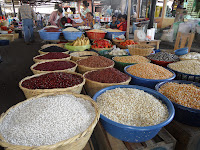Havana itself is potentially the world's most impressive city. On a grand scale, full of wide boulevards, with every house an antique. I say potentially, because the houses remain unpainted, with many slowly crumbling. A fading beauty as someone called her.
Still, from the people I've talked to, there seems to be strong support for the Government and for the principles of the Revolution. People still talk of "the Revolution" as if it was yesterday. There seems to be a fear that were the Government to change, there would be a return to the divide between the very rich and very poor that jump-started the revolution in the first place. Ironically the on-set of tourism, badly needed to spur the economy on, is partly contributing to this. In Cuba, there are two currencies. There´s the ´Cuba Convertibles´ used by the tourists. These can be exchanged for US currency (dollar for dollar). Then there´s the domestic currency which looks very similar to Cuba Convertibles but can not be exchanged for foreign currency. The real ecomony which lies beneath the tourist´s reach exchanges the local currency for CCs at a rate of 24 to 1. This means that the CCs are extremely valuable and those with access to the tourist dollar - restaurants, hotels and homestays (where families open a room in their house for tourists to stay - strictly regulated) are likely to become the new financial elite as tourism continues to expand.





































